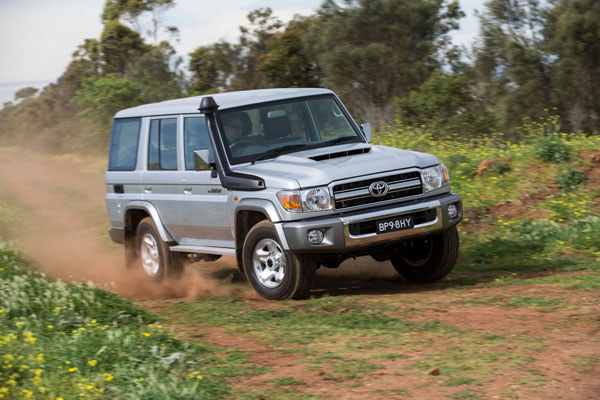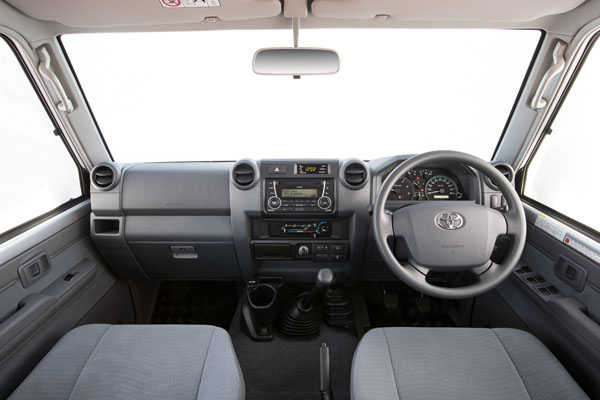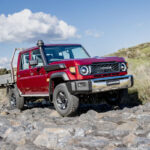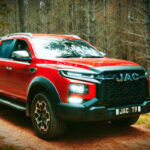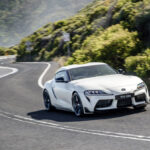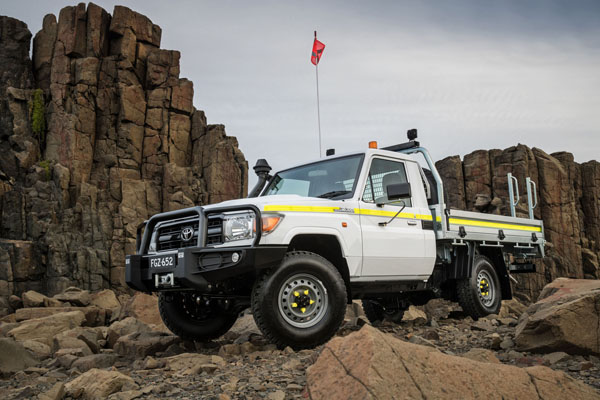 The farmers’ friend; the miners’ mate nearly didn’t make it. In some quarters it was thought Toyota’s LandCruiser 70 Series workhorse, after more than three decades, had run its course.
The farmers’ friend; the miners’ mate nearly didn’t make it. In some quarters it was thought Toyota’s LandCruiser 70 Series workhorse, after more than three decades, had run its course.
However, they had not reckoned on a cohort of Aussie owners who had used the ‘go almost anywhere’ 70 Series in the most challenging terrain to do the toughest jobs.
So five years ago Toyota set chief engineer Sadayoshi Koyari and a team of Australian engineers and their Japanese counterparts the task of coming up with a new model worthy of carrying the tag of toughness and reliability well into the 21st century.
Body styles include wagon, troop carrier, double and single cab-chassis with grades of WorkMate, GX and GXL. Prices start at $60,990, plus on-road costs, for the WorkMate wagon and top out at $68,990 for the GXL double cab-chassis.
Upgrades across the range include a re-engineered single cab-chassis, which now earns a maximum five-star ANCAP safety rating to satisfy workplace health and safety regulations.
This is achieved with a new frame that is larger and stiffer, additional airbags, revised body panels, new front seats and a list of changes that improve safety. For example, all variants are fitted with vehicle stability control, active traction control, hill start assist, plus ABS brakes with brake assist and electronic brake force distribution. Cruise control is also standard.
The WorkMate now has split-rim steel wheels in the form of a wider single-piece 16-inch style matched to tubeless tyres.
However, customers have a right to feel slighted by the fact that air-conditioning is a $2761 option.
The 4.4-litre turbo-diesel V8 engine has been upgraded with better responsiveness for more relaxed driving, at the same cutting fuel consumption by up to 10.1 per cent and improving exhaust emissions (Euro 5).
This is the result of the addition of a diesel particulate filter and piezo-electric fuel injectors, while the five-speed manual transmission gearing is taller in second and fifth gears.
The direct injection common-rail diesel motor delivers 151 kW of power at just 3400 rpm and 430 Nm of torque across a wide rev range, from 1200 to 3200 rpm.
Star performer, the single cab-chassis, with its beefed-up frame and thicker body panels improving safety, also sees an improvement in noise, vibration and harshness. As well as improved handling without detracting from ride comfort.
The steering link has been shifted to the rear of the front axle for protection, requiring, like the wagon and double cab-chassis models, a single 130-litre fuel tank.
The new vehicle stability control automatically disengages in low range. Active traction control, which has taken away the need for a limited-slip differential, works in high and low range, but can be turned off for sand.
A hill-hold facility prevents the vehicle rolling back on an incline for two seconds.
There are now five airbags, with the addition of two side curtain and driver’s knee airbag. Seats have been remodelled to add comfort and give more protection from whiplash.
Accessories can now be hooked up via bank of ten fuses in the engine compartment.
Towing capacity tops out at 3500 kg.
One of the few changes to single-cab exterior styling – 70 Series buyers are a mainly conservative bunch – is a pronounced power bulge on the bonnet, contributing to enough clearance above engine bay components to satisfy pedestrian impact requirements.
The Aussie engineers were given the task of extensive local development, including mating the suspension calibration with the new more robust frame.
Five years later and with more than 100,000 kilometres on the clock, 70 per cent of it off-road in some of the most demanding conditions, they have come up with what they think is a vehicle worthy of the 70 Series label.
Our test driving of the LC70 began on a far-from demanding run through the Melbourne city suburbs and highway. In a single cab-chassis we had little cause for complaint, riding uneven surfaces smoothly and pulling out to overtake with ease thanks to its 430 Nm of torque chipping in at a low 1200 revs. Steering was a bit vague.
One complaint, the non-electrical exterior mirror adjustment is from the ark and the driver’s side on the test vehicle was blown out of whack at speed and had repeatedly to be readjusted.
All vehicles tested were equal to the tasks thrown up by an extensive off-road program that included dirt track, mud holes, steep inclines over rock and river crossings. Traction control and hill-hold came into their own.
It’s easy to appreciate the value of local testing – sand and snow remaining the only mystery on the day.
Toyota Australia executive director of sales and marketing Tony Cramb says for more than 30 years miners, farmers, governments and private buyers have turned to the LandCruiser 70 Series to meet their demands.
“Toyota Australia was determined to return their loyalty, and with the support of our parent company, devoted significant resources to ensure we and our dealers could continue to meet demand. The only alternative was to walk away from this model. That was not an option.”
The you-beaut upgrades, albeit to only one variant, the single cab, have finally brought the 70 Series into the 21st century. Has Toyota made the right call by not dragging more models across? A high price for old technology? Loyalty could be on the line here.
MODEL LINE-UP
LandCruiser 70 Series WorkMate wagon: $60,990
LandCruiser 70 Series GXL wagon: $64,990
LandCruiser 70 Series WorkMate troop carrier: $64,890
LandCruiser 70 Series GXL troop carrier: $67,990
LandCruiser 70 Series double cab-chassis WorkMate: $64,990
LandCruiser 70 Series GXL double cab-chassis: $68,990
LandCruiser 70 Series WorkMate single cab-chassis: $62,490
LandCruiser 70 Series GX single cab-chassis: $64,490
LandCruiser 70 Series GXL single cab-chassis: $66,490
Note: These prices do not include government or dealer delivery charges. Contact your local Toyota dealer for drive-away prices.




